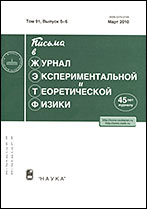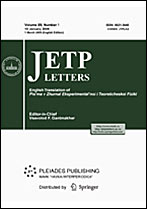|
This article is cited in 2 scientific papers (total in 2 papers)
PLASMA, HYDRO- AND GAS DYNAMICS
Precursors in gas-liquid mixtures
V. G. Gasenkoa, R. S. Gorelika, V. E. Nakoryakovab, L. S. Timkinb
a Institute of Thermophysics, Siberian Branch of the Russian Academy of Science
b Novosibirsk State University
Abstract:
Two types of precursors propagating at the speed of sound in a pure liquid have been revealed in the experiments on the evolution of pressure pulses in a gas-liquid mixture; at the same time, the main pressure pulse propagates at a low equilibrium speed of sound and its evolution is described by the Burgers–Korteweg–de Vries equation. The first high-frequency precursor is a complete analog of a classical Sommerfeld precursor, because the resonance dispersion equation for a bubble mixture coincides with that for insulators in the Lorentz model, and oscillates at a frequency close to the “plasma frequency”. The second low-frequency precursor has been revealed in this work. The frequency of the low-frequency precursor is close to the resonance frequency of pulsations of bubbles, which is almost an order of magnitude lower than the frequency of the high-frequency precursor. The low-frequency precursor has a much larger amplitude of pulsations and smaller damping and is not described within the homogeneous model of the gas-liquid mixture. The observed phenomenon of low-frequency precursors has been explained within a simple heterogeneous model of a bubble liquid.
Received: 19.03.2013
Revised: 09.06.2013
Citation:
V. G. Gasenko, R. S. Gorelik, V. E. Nakoryakov, L. S. Timkin, “Precursors in gas-liquid mixtures”, Pis'ma v Zh. Èksper. Teoret. Fiz., 98:4 (2013), 221–227; JETP Letters, 98:4 (2013), 195–200
Linking options:
https://www.mathnet.ru/eng/jetpl3494 https://www.mathnet.ru/eng/jetpl/v98/i4/p221
|


| Statistics & downloads: |
| Abstract page: | 248 | | Full-text PDF : | 100 | | References: | 49 | | First page: | 1 |
|





 Contact us:
Contact us: Terms of Use
Terms of Use
 Registration to the website
Registration to the website Logotypes
Logotypes








 Citation in format
Citation in format 
